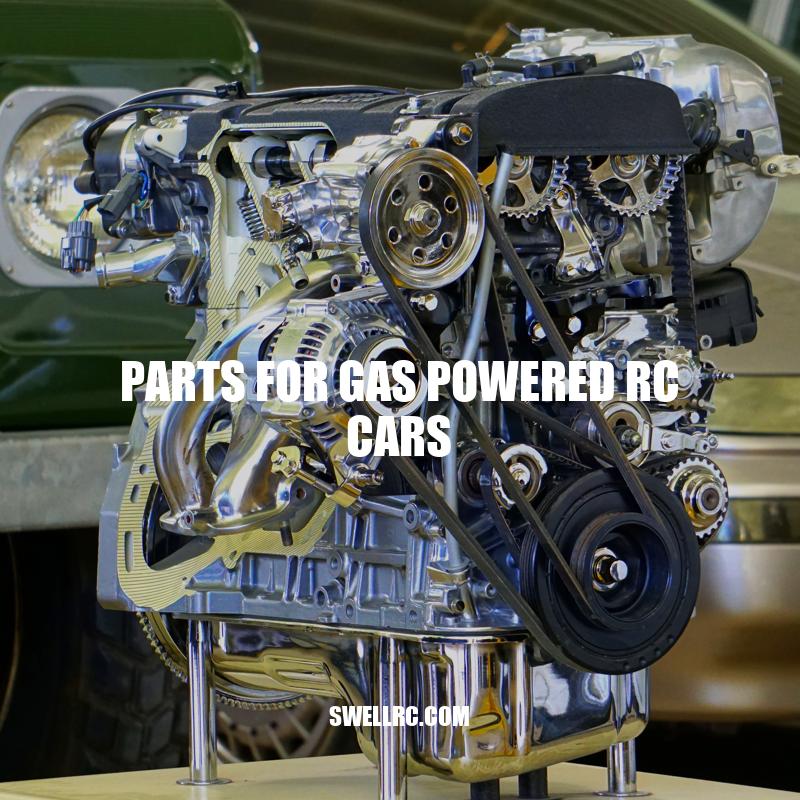Ultimate Guide: Parts for Gas-Powered RC Cars
Gas powered RC cars are a thrilling hobby for both beginners and seasoned enthusiasts. These miniature cars are capable of high speeds and excellent maneuverability, making them ideal for racing and off-road adventures. However, to keep your gas-powered RC car running smoothly and efficiently, regular maintenance and repairs are essential. It’s vital to understand the different parts of your RC car to ensure it performs at its best. A well-maintained gas-powered RC car will provide you with hours of fun and excitement. To maintain your RC car, you must commit to regular maintenance, including cleaning, checking oil levels, and replacing parts. This article will discuss the different parts of a gas-powered RC car, including engine and exhaust parts, suspension and steering parts, and transmission and brake parts. Understanding these parts will help you identify when you need to repair, replace or upgrade them to ensure maximum performance and longevity of your RC car.
Parts for Gas Powered RC Cars
The engine and exhaust system are critical to the performance of a gas-powered RC car. Here are some of the essential parts in these systems:
- Carburetor: The carburetor mixes the fuel and air in the engine
- Fuel tank: This is where you store the fuel
- Spark plug: The spark plug ignites the fuel mixture in the engine
- Muffler: The muffler reduces engine noise
- Header: The header connects the engine to the exhaust system
Regular maintenance of the engine and exhaust system is crucial to the longevity of your RC car. To keep your engine running smoothly, change the fuel filter regularly and use high-quality fuel. For the exhaust system, ensure that the muffler and header are secured and free from damage. A damaged muffler or header will negatively affect the system’s performance. Consider upgrading your engine or exhaust system for better performance. Websites like HobbyTown and RC Planet offer a wide range of gas-powered RC car parts, including engines and exhaust systems.
What regular maintenance is required for gas-powered RC cars?
If you are a proud owner of a gas-powered RC car, you know how important it is to keep up with regular maintenance to make sure your car performs at its best. Regular maintenance not only prolongs the lifespan of your car, but it also ensures that it operates safely.
One of the most important things you can do is to make sure to clean your car regularly. This includes removing debris, mud or dirt from the body, wheels, and engine components. You can use a soft brush, cloth, and compressed air to remove any loose dirt and debris.
Another important part of car maintenance is checking the fuel and oil levels. You should regularly check to make sure that your gas tank is topped up and that there’s enough oil in the engine. Low fuel or oil levels can cause significant engine damage.
Don’t forget to periodically inspect your RC car for any loose or worn-out parts, especially after a rough ride. You should make sure that all bolts, screws, and nuts are tightened properly, that the wheels turn freely, and that there are no cracks or deformities on your car’s body.
Lastly, you should also regularly tune your engine for optimal performance. It includes adjusting the air-fuel mixture, idle speed, and overall engine performance. Tinkering with the engine can take some trial and error. So, familiarize yourself with your user manual or seek the advice of an experienced RC mechanic.
In summary, maintaining a gas-powered RC car requires regular cleaning, checking fuel and oil levels, inspecting for any loose or worn-out parts, and tuning the engine. By keeping up with routine maintenance, you’ll ensure that your car performs at its best.
The Suspension and Steering Parts
A gas-powered RC car’s suspension and steering system ensures stable and safe driving performance. Here’s a list of the essential suspension and steering parts:
- Shock absorbers: The shock absorbers cushion the car from bumps and vibrations.
- Springs: The springs support the weight of the car and absorb shocks.
- Linkages: The linkages connect the suspension to the steering system.
- Ball joints: The ball joints allow the suspension to move freely and absorb shocks.
- Servos: The servos are motorized components that control the steering system.
Gas-powered RC cars also have different suspension systems:
| Suspension Type | Description |
|---|---|
| Independent suspension | Each wheel is attached independently to the suspension system, providing better handling and stability for the car. |
| Semi-independent suspension | The wheels on one side of the car are connected to the same solid axles, providing stable driving but less flexibility on uneven terrain. |
| Solid axle suspension | Front and rear wheels are connected to a solid axle, providing a simple and easy to maintain suspension system. |
Consider upgrading your suspension and steering system to improve your RC car’s performance. Websites like AMain Hobbies and Tower Hobbies offer a wide range of gas-powered RC car parts, including suspension and steering systems. Did you know that gas-powered RC cars can reach speeds of up to 70 mph? A good suspension system ensures a smooth and stable driving experience even at high speeds.
What are the different types of suspension systems for gas-powered RC cars?
Gas-powered RC cars are a thrilling hobby for many enthusiasts and require a certain level of knowledge on how the different components work together for optimal performance. One crucial component are the suspension systems, which affect how the car handles on different terrains. Let’s take a look at the different types of suspension systems commonly used in gas-powered RC cars.
Firstly, the most basic type of suspension system is the spring and damper setup. This type of suspension uses a set of springs and dampers on each wheel to absorb shocks and vibrations, keeping the car stable as it travels over obstacles. This type of suspension is great for beginners as it is easy to understand and adjust, and generally less expensive than other systems.
Next, we have the double-wishbone suspension system. This type of suspension is commonly used in high-performance RC cars, as it offers a wider range of adjustability for the user. The double-wishbone system uses two wishbone-shaped arms on each wheel, allowing for a more intricate level of control over the car’s handling and performance.
Another commonly used suspension system is the trailing arm suspension, which is great for off-road usage. This type of suspension uses a single longitudinal arm that balances the car as it moves over rough terrain or uneven surfaces. Trailing arm suspensions are also relatively simple to adjust as they use fewer components compared to other types of suspension systems.
Finally, we have the independent suspension system, which is the most advanced type of suspension used in gas-powered RC cars. This type of suspension uses multiple arms and linkages on each wheel that allow for individual adjustment of each wheel’s movement. Independent suspension systems offer the most precise control over a car’s handling and performance, making them perfect for competitive racing or off-road driving.
In conclusion, the type of suspension system used in a gas-powered RC car will depend on the driver’s experience level, the intended usage of the car and budget. By understanding the different types of suspension systems available, drivers can make informed decisions when selecting the best option for their needs.
The Transmission and Brake Parts
The transmission and brake system of a gas-powered RC car are crucial to its performance and safety. Here are some of the essential transmission and brake parts:
- Clutch: The clutch is responsible for transferring power from the engine to the transmission smoothly.
- Gears: The gears control the car’s speed by changing the ratio of revolutions between the engine and the wheels.
- Drive shafts: The drive shafts transmit power from the transmission to the wheels.
- Brakes: The brake system provides safe stopping capability for the car.
- Brake pads: The brake pads are a replaceable component that wears down over time and requires regular maintenance.
Gas-powered RC cars have different types of transmission systems:
| Transmission Type | Description |
|---|---|
| Automatic transmission | The car’s speed is automatically adjusted according to the terrain, providing a smooth driving experience even for beginners. |
| Manual transmission | The driver must manually adjust the gears using a servo system, providing better control and flexibility. |
| Two-speed transmission | Allows for faster acceleration and high-speed driving but requires more maintenance. |
Check out websites like AMain Hobbies and Tower Hobbies, which offer a wide range of gas-powered RC car parts, including transmission and brake systems. Interesting fact: The first remote-control car was developed by the Italian company Elettronica Giocattoli in 1966. With proper care and maintenance, your gas-powered RC car’s transmission and brake system will provide excellent driving performance and stability, allowing you to enjoy the thrill of high-speed racing and off-road adventures for years to come.
What are the different types of transmission systems available for gas-powered RC cars?
Gas-powered RC cars are the ultimate thrill for enthusiasts who crave high-speed racing and a fun-filled ride. The power source of these miniature vehicles comes from gasoline engines that run on a fuel mixture of gasoline and oil. When you step on the throttle, what happens next is largely dependent on the type of transmission system your RC car has. So, what are the different types of transmission systems available for gas-powered RC cars?
One of the most common types of transmission for gas-powered RC cars is the belt-driven system. This setup uses a belt made of high-tension rubber to transfer power from the engine to the wheels. Belt drives are known for their smooth power delivery, which allows for finely tuned acceleration and speed control. They are also easy to maintain and have a long lifespan.
Another popular option is the shaft-driven transmission, which uses a series of gears to transfer power from the engine to the wheels. This system is known for its durability and ability to handle high-torque situations. It’s an excellent choice for off-road racing or other types of terrain that require more power.
Finally, there’s the ball differential, which is a common type of transmission used in RC cars of all types. This system is designed to limit slip between the wheels, allowing for better control and handling. It’s often used with on-road RC cars, where speed and precision are crucial.
In conclusion, the choice of transmission system for your gas-powered RC car is dependent on your specific needs and preferences. Whether you prefer smooth power delivery, durability, or better handling, there’s a transmission system out there that will suit your needs.
Conclusion
In conclusion, gas-powered RC cars are a fantastic hobby that provides hours of excitement and fun. The key to getting the most out of your car is to take good care of it. Regular maintenance is essential, and so is investing in high-quality parts. Understanding the different parts of your gas-powered RC car, such as the engine and exhaust, suspension and steering, and transmission and brake system, is critical to ensuring your car performs at its best.
It’s also crucial to remember that gas-powered RC cars can be dangerous, especially when operated improperly. Always read and follow the manufacturer’s instructions, and make sure you operate your car in a safe and appropriate environment.
Lastly, consider joining an RC car club or community to learn more about this exciting hobby. You can connect with other enthusiasts, share tips and tricks, and participate in races and events. With the right care, maintenance, and knowledge, your gas-powered RC car can provide years of thrilling racing and off-road experiences.



